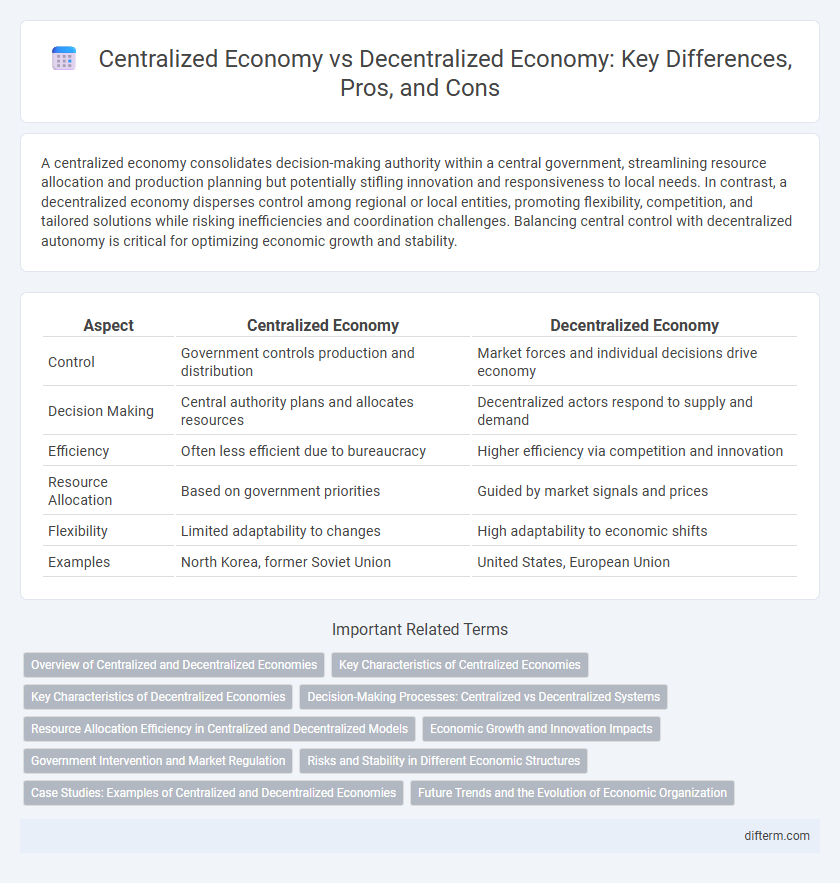A centralized economy consolidates decision-making authority within a central government, streamlining resource allocation and production planning but potentially stifling innovation and responsiveness to local needs. In contrast, a decentralized economy disperses control among regional or local entities, promoting flexibility, competition, and tailored solutions while risking inefficiencies and coordination challenges. Balancing central control with decentralized autonomy is critical for optimizing economic growth and stability.
Table of Comparison
| Aspect | Centralized Economy | Decentralized Economy |
|---|---|---|
| Control | Government controls production and distribution | Market forces and individual decisions drive economy |
| Decision Making | Central authority plans and allocates resources | Decentralized actors respond to supply and demand |
| Efficiency | Often less efficient due to bureaucracy | Higher efficiency via competition and innovation |
| Resource Allocation | Based on government priorities | Guided by market signals and prices |
| Flexibility | Limited adaptability to changes | High adaptability to economic shifts |
| Examples | North Korea, former Soviet Union | United States, European Union |
Overview of Centralized and Decentralized Economies
Centralized economies rely on a single authority, usually the government, to control production, distribution, and pricing of goods and services, aiming to allocate resources efficiently and achieve economic goals. Decentralized economies operate through market forces and private enterprises, promoting competition, innovation, and consumer choice by allowing supply and demand to dictate economic activities. The centralized model often emphasizes stability and uniformity, while the decentralized approach prioritizes flexibility and responsiveness to market changes.
Key Characteristics of Centralized Economies
Centralized economies are characterized by state ownership of resources and centralized decision-making, where government authorities control production, distribution, and pricing. These economies rely on comprehensive planning to allocate resources efficiently and achieve specific economic goals, often emphasizing equality and social welfare. Centralized control limits market forces and private enterprise, resulting in reduced competition and innovation.
Key Characteristics of Decentralized Economies
Decentralized economies rely on distributed decision-making processes where individual agents such as businesses and consumers autonomously allocate resources based on market signals, promoting flexibility and innovation. Price mechanisms play a crucial role in efficiently balancing supply and demand without centralized control, fostering competitive markets and adaptability to local needs. This economic structure enhances transparency and reduces bureaucratic delays, enabling faster responses to changing economic conditions and consumer preferences.
Decision-Making Processes: Centralized vs Decentralized Systems
Centralized economies concentrate decision-making authority within a central government or planning entity, facilitating uniform policy implementation and resource allocation. Decentralized economies distribute decision-making power across multiple local or regional authorities, fostering innovation and responsiveness to local needs. The efficacy of each system depends on balancing control with flexibility to optimize economic growth and efficiency.
Resource Allocation Efficiency in Centralized and Decentralized Models
Centralized economies allocate resources through a central authority, which can lead to inefficiencies due to lack of localized information and slower responsiveness to market changes. Decentralized economies enhance resource allocation efficiency by leveraging market signals and individual decision-making, allowing for more adaptive and dynamic distribution of resources. Studies show decentralized models often outperform centralized systems in optimizing resource use and responding to consumer demands.
Economic Growth and Innovation Impacts
Centralized economies often experience slower economic growth due to limited market competition and bureaucratic inefficiencies, which can stifle innovation. In contrast, decentralized economies promote dynamic market competition and entrepreneurial activities, driving faster economic growth and fostering sustained technological innovation. Empirical studies highlight that decentralized systems enhance resource allocation efficiency and incentivize creative problem-solving, leading to higher productivity and innovation output.
Government Intervention and Market Regulation
Government intervention in a centralized economy involves extensive control over resource allocation, production, and pricing, aiming to achieve economic stability and equitable distribution. In contrast, decentralized economies rely on limited government regulation, allowing market forces to determine supply, demand, and prices, fostering competition and innovation. Market regulation in centralized systems often restricts private enterprise to prioritize social welfare, whereas decentralized systems emphasize deregulation to promote efficiency and consumer choice.
Risks and Stability in Different Economic Structures
Centralized economies concentrate decision-making authority within the government, which can lead to systemic risks such as inefficiencies and slow responses to market changes, potentially destabilizing the economy during crises. Decentralized economies distribute economic control across various private and regional actors, enhancing adaptability and innovation while exposing the system to market volatility and coordination challenges. Stability in economic structures depends on balancing centralized oversight with decentralized flexibility to mitigate risks like resource misallocation and financial shocks.
Case Studies: Examples of Centralized and Decentralized Economies
China exemplifies a centralized economy through its state-controlled industries and strategic planning that directs resources and production. In contrast, the United States represents a decentralized economy with market-driven forces, private enterprise dominance, and minimal government intervention. These case studies highlight how centralized economies prioritize government control to achieve stability and growth, while decentralized economies leverage individual entrepreneurship and competition for innovation and efficiency.
Future Trends and the Evolution of Economic Organization
Centralized economies, characterized by government control over resource allocation and production, are increasingly challenged by the rise of decentralized economic models driven by blockchain technology and peer-to-peer networks. Future trends indicate a shift towards hybrid systems that combine centralized regulation with decentralized innovation to enhance efficiency, transparency, and resilience. The evolution of economic organization favors adaptability and distributed decision-making to respond to global market complexities and technological advancements.
Centralized Economy vs Decentralized Economy Infographic

 difterm.com
difterm.com